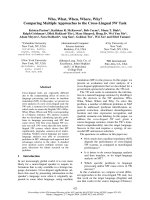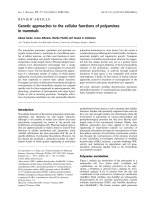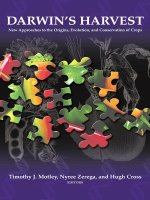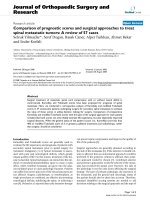Ebook Surgical approaches to the facial skeleton (3/E): Part 1
Bạn đang xem bản rút gọn của tài liệu. Xem và tải ngay bản đầy đủ của tài liệu tại đây (37.76 MB, 259 trang )
Surgical
Approaches to the
Facial
Skeleton
THIRD EDITION
2
Surgical
the
Approaches
Facial
Skeleton
THIRD EDITION
EDITORS
EDWARD ELLIS III, DDS, MS
Professor, Oral and Maxillofacial Surgery
Director of Residency Training
The University of Texas Southwestern Medical Center and
Chief of Oral and Maxillofacial Surgery
Parkland Memorial Hospital
Dallas, Texas
MICHAEL F. ZIDE, DMD
Associate Director, Oral and Maxillofacial Surgery
John Peter Smith Hospital
Fort Worth, Texas
VIDEO EDITORS
ERIC W. WANG, MD
Associate Professor
Department of Otolaryngology
University of Pittsburgh School of Medicine
Director
3
to
Maxillofacial Trauma
UPMC Presbyterian Hospital
Pittsburgh, Pennsylvania
JENNY Y. YU, MD
Vice Chair, Clinical Operations
Department of Ophthalmology
Assistant Professor
Department of Ophthalmology and Otolaryngology
University of Pittsburgh Medical Center
Pittsburgh, Pennsylvania
Illustrations by Jennifer Carmichael, MA and Lewis Calver, BFA, MS
4
Acquisitions Editor: Keith Donnellan
Marketing Manager: Stacy Malyil
Production Project Manager: Kim Cox
Design Coordinator: Stephen Druding
Editorial Coordinator: Dave Murphy
Manufacturing Coordinator: Beth Welsh
Prepress Vendor: SPi Global
Third edition
Copyright © 2019 Wolters Kluwer
Copyright © 2006 by Lippincott Williams & Wilkins. Copyright © 1995 J. B.
Lippincott Company. All rights reserved. This book is protected by copyright. No
part of this book may be reproduced or transmitted in any form or by any means,
including as photocopies or scanned-in or other electronic copies, or utilized by
any information storage and retrieval system without written permission from the
copyright owner, except for brief quotations embodied in critical articles and
reviews. Materials appearing in this book prepared by individuals as part of their
official duties as U.S. government employees are not covered by the abovementioned copyright. To request permission, please contact Wolters Kluwer at
Two Commerce Square, 2001 Market Street, Philadelphia, PA 19103, via email at
, or via our website at lww.com (products and services).
9 8 7 6 5 4 3 2 1
Printed in China (or the United States of America)
Library of Congress Cataloging-in-Publication Data
Names: Ellis, Edward, DDS, author. | Zide, Michael F., author.
Title: Surgical approaches to the facial skeleton / Edward Ellis, III, Michael F. Zide
; surgical videos by Eric W. Wang, Jenny Y. Yu.
Description: Third edition. | Philadelphia : Wolters Kluwer, [2018] | Includes
bibliographical references and index.
Identifiers: LCCN 2017058293 | ISBN 9781496380418 (hardback)
Subjects: | MESH: Facial Bones—surgery
Classification: LCC RD523 | NLM WE 705 | DDC 617.5/2059—dc23 LC record
available at />This work is provided “as is,” and the publisher disclaims any and all warranties,
express or implied, including any warranties as to accuracy, comprehensiveness, or
currency of the content of this work.
This work is no substitute for individual patient assessment based upon healthcare
professionals’ examination of each patient and consideration of, among other
5
things, age, weight, gender, current or prior medical conditions, medication history,
laboratory data and other factors unique to the patient. The publisher does not
provide medical advice or guidance and this work is merely a reference tool.
Healthcare professionals, and not the publisher, are solely responsible for the use
of this work including all medical judgments and for any resulting diagnosis and
treatments.
Given continuous, rapid advances in medical science and health information,
independent professional verification of medical diagnoses, indications,
appropriate pharmaceutical selections and dosages, and treatment options should
be made and healthcare professionals should consult a variety of sources. When
prescribing medication, healthcare professionals are advised to consult the product
information sheet (the manufacturer's package insert) accompanying each drug to
verify, among other things, conditions of use, warnings and side effects and
identify any changes in dosage schedule or contraindications, particularly if the
medication to be administered is new, infrequently used or has a narrow
therapeutic range. To the maximum extent permitted under applicable law, no
responsibility is assumed by the publisher for any injury and/or damage to persons
or property, as a matter of products liability, negligence law or otherwise, or from
any reference to or use by any person of this work.
LWW.com
6
Dedication
Plant a seed and it will grow.
There are many who have unknowingly contributed to this book through
the education
they have provided me. All were my teachers, all are my friends. This book
is dedicated
to these special individuals:
Robert Bruce
Amir El-Attar
W. James Gallo
James Hayward
Kazumas Kaya
Khursheed Moos
Timothy Pickens
Gilbert Small
George Upton
Al Weiss
EDWARD ELLIS III
In gratitude for ageless friendship and counsel. Doug Sinn, DDS, Jack
Kent, DDS,
and Robert V. Walker, DDS.
To Riki: who puts up with me still.
MICHAEL F. ZIDE
7
PREFACE
There are many reasons for exposing the facial skeleton. Treatment of
facial fractures, management of paranasal sinus disease, esthetic onlay and
recontouring procedures, elective osteotomies, treatment of secondary
traumatic deformities such as enophthalmos, placement of endosteal
implants, and a host of other reconstructive procedures require approaches
to the facial framework. Many approaches to a given skeletal region are
possible. The choice is made usually on the basis of the surgeon's training,
experience, and bias. This book does not advocate one approach over
another, although the advantages and disadvantages of each approach will
be listed. We maintain the age-old belief that “many roads lead to Rome.”
Therefore, the purpose of this book is to describe in detail the anatomical
and technical aspects of most of the commonly used surgical approaches to
the facial skeleton. We have deliberately not presented every approach,
because many of them are not universally used, or are so simple that
nothing needs to be said. However, the approaches presented in this book
will allow the surgeon complete access to the craniofacial skeleton for
whatever skeletal procedure is being performed.
We have attempted, from the beginning, to make Surgical Approaches
to the Facial Skeleton different from the other books that touch on this
subject. Most books that discuss surgical approaches do so in the context
of the surgical procedure that is being presented. For instance, a book on
facial fractures will usually present surgical approaches to a particular
facial fracture. However, the surgical approach is not generally given
much consideration or is it presented in sufficient detail for the novice.
The reader is often left with the question, “How did the author get from the
skin to that point on the skeleton?” We instead avoid consideration of why
one is exposing the skeleton and describe the approaches in great detail so
that even the novice can safely approach the facial skeleton by following
the step-by-step description we have provided.
This book assumes that the reader has some basic understanding of
regional anatomy, especially osteology. However, the anatomic structures
8
of greatest interest will still be discussed for each surgical approach. This
book also assumes that the reader has developed skills for the careful
handling of soft tissues. We have suggested the use of those instruments
that we have found useful for incising, retracting, and manipulating the
tissues involved with each surgical approach, recognizing that others are
also appropriate. The book also assumes that the reader is skilled in facial
soft tissue closure. We have not discussed skin closure techniques
associated with the approaches unless they differ from routine skin
closures.
The first edition of Surgical Approaches to the Facial Skeleton became
a hit with surgeons from several specialties when it was published in 1995.
Oral and maxillofacial surgeons, plastic surgeons, and otolaryngologists all
wanted this book for their collections. The book was most popular,
however, among residents-in-training from these specialties.
The third edition of Surgical Approaches to the Facial Skeleton, like
the first two editions, contains 14 chapters, 13 of which describe a specific
surgical approach. The first chapter discusses basic principles involved in
surgical approaches. The remaining 13 chapters are organized into
sections, predominantly on the basis of the region of the face being
exposed. There will often be more than one surgical approach presented
for each region, with the choice left to the surgeon. We attempt to point
out the advantages and disadvantages of each as they are presented.
The major change in the third edition of Surgical Approaches to the
Facial Skeleton is the addition of videos. Drs. Eric Wang and Jenny Yu
provide narrated videos that demonstrate 12 key approaches as performed
on cadavers.
Edward Ellis III, DDS, MS
Michael F. Zide, DMD
9
Contents
Preface
Section 1 Basic Principles for Approaches to the Facial
Skeleton
1 Basic Principles for Approaches to the Facial Skeleton
Section 2 Periorbital Incisions
2
3
4
5
Transcutaneous Approaches Through the Lower Eyelid
Transconjunctival Approaches
Supraorbital Eyebrow Approach
Upper Eyelid Approach
Section 3 Coronal Approach
6 Coronal Approach
Section 4 Transoral Approaches to the Facial Skeleton
7 Approaches to the Maxilla
8 Mandibular Vestibular Approach
Section 5 Transfacial Approaches to the Mandible
9 Submandibular Approach
10 Retromandibular Approach
11 Rhytidectomy Approach
10
Section 6 Approaches to the Temporomandibular Joint
12 Preauricular Approach
Section 7 Surgical Approaches to the Nasal Skeleton
13 External (Open) Approach
14 Endonasal Approach
Index
11
Surgical
Approaches to the
Facial
Skeleton
THIRD EDITION
12
SECTION 1
Basic Principles for
Approaches to the Facial
Skeleton
13
1
Basic Principles for
Approaches to the
Facial Skeleton
Maximum success in skeletal surgery depends on adequate access to and
exposure of the skeleton. Skeletal surgery is simplified and expedited
when the involved parts are sufficiently exposed. In orthopaedic surgery,
especially of the appendicular skeleton, the basic rule is to select the most
direct approach possible to the underlying bone. Therefore, incisions are
usually placed very near the area of interest while major nerves and blood
vessels are retracted. This involves little regard for esthetics but allows the
orthopaedic surgeon greater leeway in the location, direction, and length of
the incision.
Surgery of the facial skeleton, however, differs from general
orthopaedic surgery in several important ways. The first factor in incision
placement is not surgical convenience but facial esthetics. The face is
plainly visible to everyone, and a conspicuous scar may create a cosmetic
deformity that can be as troubling to the individual as the reason for which
the surgery was performed. Cosmetic considerations are critical in light of
the emphasis that most societies place on facial appearance. Therefore, as
we will see in this book, all the incisions made on the face must be placed
in inconspicuous areas, sometimes distant from the underlying osseous
skeleton on which the surgery is being performed. For instance, placement
of incisions in the oral cavity allows superb exposure of most of the facial
14
skeleton, with a completely hidden scar.
The second factor that differentiates incision placement on the face
from incisions placed anywhere else on the body is the presence of the
muscles and nerve (cranial nerve VII) of facial expression. The muscles
are subcutaneous structures, and the branches of the facial nerve that
supply them can be traumatized if incisions are made in their path. This
can result in a “paralyzed” face, which is not only a severe cosmetic
deformity but can also have great functional ramifications. For instance, if
the ability to close the eye is lost, corneal damage can ensue, affecting
vision. Therefore, placement of incisions and dissections that expose the
facial skeleton must ensure that damage to the facial nerve is minimized.
Many dissections to expose the skeleton require care and electrical nerve
stimulation to identify and protect the nerve. Approaches using incisions in
the facial skin must also take into consideration the muscles of facial
expression. This is especially important for approaches to the orbit, where
the orbicularis oculi muscle must be traversed. Closure of some incisions
also affects the muscles of facial expression. For instance, if a maxillary
vestibular incision is closed without proper reorientation of the perinasal
muscles, the nasal base will widen.
The third factor in facial incision placement is the presence of many
important sensory nerves exiting the skull at multiple locations. The facial
soft tissues have more sensory input per unit area than soft tissues
anywhere else in the body. Loss of this sensory input can be a great
inconvenience to the individual. Therefore, the incisions and approaches
used must avoid injury to the sensory nerves. An example is dissection of
the supraorbital nerve from its foramen/notch in the coronal approach.
Other important factors are the patient’s age, existing unique anatomy,
and expectations. The age of the patient is important because of the
possible presence of the wrinkles that come with age. Skin wrinkles serve
as a guide and offer the surgeon the opportunity to place incisions within
or parallel to them. Existing anatomic features that are unique to the
individual can also facilitate or hamper incision placement. For instance,
pre-existent lacerations can be used or extended to provide surgical
exposure of the underlying skeleton. The position, direction, and depth of a
laceration are important variables in determining its utility. The presence
of old scars may also direct incision placement; the old scar may be
excised and used to approach the skeleton. Sometimes, an old scar may not
lend itself to use and may even cause the new incision to be positioned
such that the old scar is avoided. Hair distribution may also direct the
position of incisions. For instance, the incision for the coronal approach is
15
largely determined by the patient’s hairline. Ethnic characteristics also
have a bearing on whether an incision will be placed in a conspicuous area.
History or ethnic propensity for hypertrophic scarring, keloid formation,
and hyper- or hypopigmentation may alter the decision as to whether or
where to place an incision.
The patient’s expectations and wishes must always be considered in
any decision about location of an incision. For instance, patients who
repeatedly require treatment of facial injuries may not be concerned with
local cutaneous approaches to the naso-orbito-ethmoid region, whereas
other individuals may be very concerned about the location of incisions.
Therefore, the choice of surgical approach depends at least partly on the
patient.
Principles of Incision Placement
Incisions placed in areas that are not readily visible, such as within the oral
cavity or far behind the hairline, are not of esthetic concern. Incisions
placed on exposed surfaces of the face, however, must follow some basic
principles so that the scar will be less conspicuous. These principles are
outlined in the following text.
Avoid Important Neurovascular Structures
Although this is an obvious consideration, avoiding anatomic hazards
during placement of incisions is only a secondary consideration in the face.
Instead, placing the incision in a cosmetically acceptable location takes
priority. Important neurovascular structures encountered during the
dissection must be dealt with by dissecting around them or by retracting
them.
Use as Long an Incision as Necessary
Many surgeons tend to use short incisions. If the soft tissues around a short
incision are stretched to obtain sufficient exposure of the skeleton, the
additional trauma from retraction may create a less satisfactory scar than a
longer incision would. A well-placed long incision may be less perceptible
than a short incision that is placed poorly or requires great retraction. A
long incision heals as quickly as a short one.
Place Incisions Perpendicular to the Surface of Non–hair16
bearing Skin
Except in some very specific regions, an incision perpendicular to the skin
surface permits the wound margins to be reapproximated in an accurate,
layer-to-layer manner. Incisions performed obliquely to the surface of the
skin are susceptible to marginal necrosis and to overlapping of the edges
during closure. Incisions in hair-bearing tissue, however, should be parallel
to the direction of the hair so that fewer follicles are transected. An oblique
incision requires a more meticulous closure because of the tendency of the
margins to overlap during suturing. Subcutaneous sutures may have to be
placed more deeply to avoid necrosis of an oblique edge.
Place Incisions in the Lines of Minimal Tension
The lines of minimal tension, also called relaxed skin tension lines, are the
result of the skin’s adaptation to function and are also related to the elastic
nature of the underlying dermis (see Fig. 1.1). The intermittent and chronic
contractions of the muscles of facial expression create depressed creases in
the skin of the face. These creases become more visible and depressed
with age. For instance, the supraorbital wrinkle lines and the transverse
lines of the forehead are caused by the contraction of the frontalis muscles,
which insert into the skin of the lower forehead. In the upper eyelids, many
fine perpendicular strands of fibers of the levator aponeurosis terminate in
the dermis of the skin and along the tarsus to form the supratarsal fold.
Similar insertions in the lower eyelid create fine horizontal lines, which are
accentuated by the circumferential contraction of the orbicularis oculi
muscle.
17
FIGURE 1.1 Lines of minimal tension (relaxed skin tension lines)
are conspicuous in the aged face. These lines or creases are good
18
choices for incision placement because the scars resulting from the
incision will be imperceptible.
Incisions should be made within the lines of minimal tension. Incisions
made within or parallel to such a line or crease will become inconspicuous
if they are closed carefully. Any incision or portion of an incision that
crosses such a crease, however, is often conspicuous.
Seek Other Favorable Sites for Incision Placement
If incisions cannot be placed within the lines of minimal tension, they can
be made inconspicuous by placement inside an orifice, such as the mouth,
nose, or eyelid; within hair-bearing areas or locations that can be covered
by hair; or at the junction of two anatomic landmarks, such as the esthetic
units of the face.
19
SECTION 2
Periorbital Incisions
20
A standard series of incisions have been used extensively to approach the
inferior, lateral, and medial orbital rims. Properly placed incisions offer
excellent access with minimal morbidity and scarring. The most
commonly used approaches are those made on the external surface of the
lower eyelid, the conjunctival side of the lower eyelid, the skin of the
lateral brow, and the skin of the upper eyelid. This section describes these
approaches. Other periorbital approaches exist and can be useful. Existing
lacerations of 2 cm or longer may also be used or extended to access the
orbit.
21
2
Transcutaneous
Approaches
Through the Lower
Eyelid
Approaches through the external side of the lower eyelid offer superb
exposure to the inferior orbital rim, the floor of the orbit, the lateral orbit,
and the inferior portion of the medial orbital rim and wall. These
approaches are given many names in the literature (e.g., blepharoplasty,
subciliary, lower- or mid-eyelid, subtarsal, infraorbital rim), based
primarily on the position of the skin incision in the lower eyelid. Because
of the natural skin creases in the lower eyelid and the thinness of eyelid
skin, scars become inconspicuous with time and do not form keloids. The
infraorbital incision, however, is almost always noticeable to some degree
(see Fig. 2.1).
22
FIGURE 2.1 Photograph showing poor cosmetic result from the
use of an infraorbital incision. Incisions placed at this level often
heal poorly for two reasons: (a) the lateral extension of the incision
usually crosses the resting skin tension lines (dots) that cause
widening of the scar (arrows) and (b) the incision is in the thicker
skin of the cheek rather than the thin skin of the eyelid.
Surgical Anatomy
Lower Eyelid
In the sagittal section, the lower eyelid (1) consists of at least four distinct
layers: the skin and subcutaneous tissue, the orbicularis oculi muscle, the
tarsus (upper 4 to 5 mm of the eyelid) or orbital septum, and the
conjunctiva (see Fig. 2.2).
23
FIGURE 2.2 Sagittal section through the orbit and globe. C,
palpebral conjunctiva; IO, inferior oblique muscle; IR, inferior
rectus muscle; OO, orbicularis oculi muscle; OS, orbital septum; P,
periosteum/periorbita; TP, tarsal plate.
24
Skin
The skin is the outermost layer, and comprises the epidermis and the very
thin dermis. The skin of the eyelids is the thinnest in the body and has
many elastic fibers that allow it to be stretched during dissection and
retraction. It is loosely attached to the underlying muscle; therefore, in
contrast to most areas of the face, relatively large quantities of fluid may
accumulate subcutaneously in this loose connective tissue. The skin
derives its blood supply from the underlying perforating blood vessels of
the muscles (see subsequent text).
Muscle
The orbicularis oculi muscle, the sphincter of the eyelids, lies subjacent
and adherent to the skin (see Fig. 2.3). This muscle completely encircles
the palpebral fissure and extends over the skeleton of the orbit. It can
therefore be divided into orbital and palpebral portions (see Fig. 2.4). The
palpebral portion can be further subdivided into the pretarsal portion (i.e.,
the muscle superficial to the tarsal plates) and the preseptal portion (i.e.,
the muscle superficial to the orbital septum). The palpebral portion of the
orbicularis oculi muscle is very thin in cross section, especially at the
junction of the pretarsal and preseptal portions. The orbital portion of the
orbicularis oculi muscle originates medially from the bones of the medial
orbital rim and the medial canthal tendon. The peripheral fibers sweep
across the eyelid over the orbital margin in a series of concentric loops, the
more central ones forming almost complete rings. In the lower eyelid, the
orbital portion extends below the inferior orbital rim onto the cheek and
covers the origins of the elevator muscles of the upper lip and nasal ala.
The orbital portion of the orbicularis oculi muscle is responsible for tight
closure of the eye.
The preseptal portion of the orbicularis oculi muscle originates from
the medial canthal tendon and lacrimal diaphragm and passes across the
eyelid as a series of half-ellipses, meeting at the lateral canthal tendon. The
upper and lower pretarsal muscles contribute to the lateral canthal tendon
which extends approximately 7 mm before inserting lateral orbital
tubercle. Medially, they unite to form the medial canthal tendon, which
inserts on the medial orbital margin, the anterior lacrimal crest, and the
nasal bones. The palpebral portion of the orbicularis oculi muscle
functions to close the eye without effort, as in blinking. It also functions to
maintain contact between the lower eyelid and the ocular globe.
25









